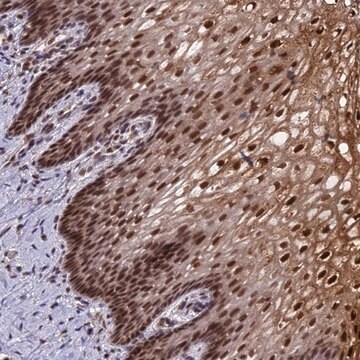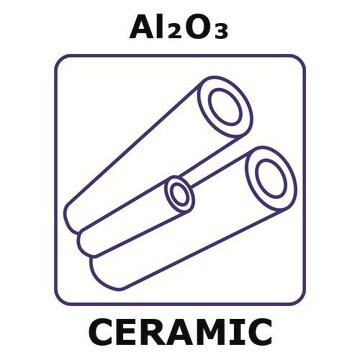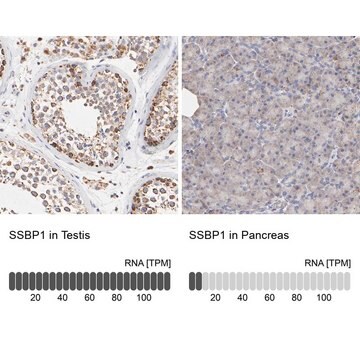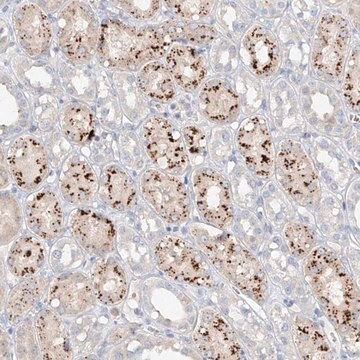MABE1057
Anti-ADA3 Antibody, clone 5C9/C8
clone 5C9/C8, from mouse
Sinónimos:
Transcriptional adapter 3, ADA3 homolog, ADA3-like protein, Alteration/deficiency in activation 3, hADA3, STAF54, Transcriptional adapter 3-like
About This Item
Productos recomendados
biological source
mouse
Quality Level
antibody form
purified immunoglobulin
antibody product type
primary antibodies
clone
5C9/C8, monoclonal
species reactivity
human, mouse
technique(s)
ChIP: suitable
immunocytochemistry: suitable
immunohistochemistry: suitable (paraffin)
western blot: suitable
isotype
IgG1κ
NCBI accession no.
UniProt accession no.
shipped in
ambient
target post-translational modification
unmodified
Gene Information
human ... TADA3(10474)
General description
Specificity
Immunogen
Application
Chromatin Immunoprecipitation (ChIP) Analysis: A representative lot detected ADA3 occupancy at the X chromosome centromere HOR region, the kinetochore assembly site also occupied by CENP-A and CENP-B, using TERT-immortalized human mammary epithelial cell 76N-TERT chromatin preparation. shRNA-mediated ADA3 knockdown led to a reduction in CENP-B, but not CENP-A, recruitment to the HOR region (Mohibi, S., et al. (2015). J. Biol. Chem. 290(47):28299-28310).
Immunocytochemistry Analysis: A representative lot detected ADA3 nuclear immunoreactivity in untransfected, but not ADA3 shRNA-transfected, TERT-immortalized human mammary epithelial 76N-TERT cells by fluorescent immunocytochemistry staining of 4% formaldehyde-fixed cells. Dual fluorescent staining revealed ADA3 and CENP-B nuclear colocalization (Mohibi, S., et al. (2015). J. Biol. Chem. 290(47):28299-28310).
Western Blotting Analysis: Representative lots detected both the endogenous mouse ADA3 (mADA3) and the exogenously expressed human ADA3 (hADA3) in Ada3FL/FL MEFs virally infected to express FLAG-tagged full-length or a.a. 111-432 hADA3 constructs. Cre recombinase expression downregulated only mADA3, but not hADA3 (Mohibi, S., et al. (2015). J. Biol. Chem. 290(47):28299-28310; Mohibi, S., et al. (2012). J. Biol. Chem. 287(35):29442-29456).
Western Blotting Analysis: A representative lot detected ADA3 expression levels among a panel of mouse tissues (Mohibi, S., et al. (2012). J. Biol. Chem. 287(35):29442-29456).
Epigenetics & Nuclear Function
Quality
Western Blotting Analysis: A 1:1,000 dilution of this antibody detected ADA3 in 10 µg of MCF-7 cell lysate.
Target description
Physical form
Storage and Stability
Other Notes
Disclaimer
¿No encuentra el producto adecuado?
Pruebe nuestro Herramienta de selección de productos.
Storage Class
12 - Non Combustible Liquids
wgk_germany
WGK 1
flash_point_f
Not applicable
flash_point_c
Not applicable
Certificados de análisis (COA)
Busque Certificados de análisis (COA) introduciendo el número de lote del producto. Los números de lote se encuentran en la etiqueta del producto después de las palabras «Lot» o «Batch»
¿Ya tiene este producto?
Encuentre la documentación para los productos que ha comprado recientemente en la Biblioteca de documentos.
Nuestro equipo de científicos tiene experiencia en todas las áreas de investigación: Ciencias de la vida, Ciencia de los materiales, Síntesis química, Cromatografía, Analítica y muchas otras.
Póngase en contacto con el Servicio técnico







